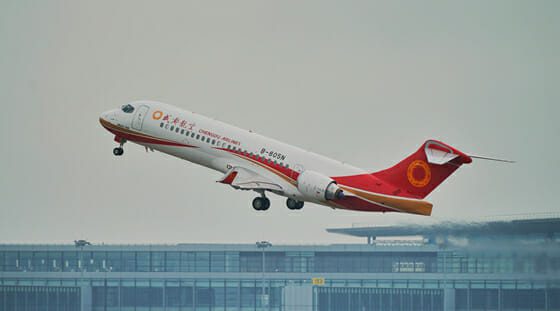
Chengdu Airlines ARJ21
China’s homegrown ARJ21 regional jetliner leaped forward, with its first commercial flight departing from a high-altitude airport on July 2nd, 2024. This historic flight, operated by Chengdu Airlines, connecting Kashgar to Tashkurgan in Xinjiang, marks a significant achievement for both the regional jet and China’s aviation ambitions.
The inaugural commercial flight marks the beginning of regular service on the Kashgar-Tashkurgan route, with three flights offered weekly, according to FlightGlobal. Tashkurgan Khunjerab Airport, the destination, sits at an impressive 3,200 meters (10,695ft) above sea level, solidifying its position as Xinjiang’s first high-altitude airport.

But this success wasn’t achieved overnight. In July 2023, the ARJ21 underwent a rigorous month-long testing program in Yunnan Province, operating multiple flights through the region’s alpine and plateau landscapes. The regional jet operated 124 flight segments across 52 routes, touching down at 15 airports, some exceeding 3,200 meters above sea level.
During this period, the total flight time it surpassed 157 hours, putting the ARJ21’s performance under intense scrutiny in challenging and varying high-altitude conditions.

Why High Altitude Matters
Thin air at high altitudes presents unique challenges for aircraft. The reduced density of oxygen can thus affect engine performance and lift generation. However, the ARJ21’s successful test flights and commercial debut demonstrate that the aircraft has overcome these hurdles.
Moreover, this achievement paves the way for the jet to serve a wider network of airports, particularly in China’s western regions, which boast some of the world’s highest-altitude civilian airports.
This development is particularly significant considering China has 24 airports classified as high-altitude (at or above 2,438m) scattered across the nation, as reported by FlightGlobal.

Looking Ahead: A Brighter Future for Regional Aviation
The ARJ21’s ability to operate to and from high-altitude airports opens doors for improved regional connectivity within China. This domestically-developed aircraft could bridge the gap between major hubs and remote destinations, boosting tourism and economic development in these areas.
The ARJ21’s success story doesn’t end here. COMAC, the aircraft’s manufacturer, is working on a high-altitude variant of their C919 narrowbody jet. Tibet Airlines, the launch customer, has already signed for 40 of these planes, demonstrating confidence.
Meanwhile, the ARJ21 is expanding its global reach. In mid-June, Chengdu Airlines made history with the first ARJ21 flight in Central Asia, linking Kashgar to Khujand in Tajikistan. The success of the ARJ21 program could inspire further innovation in China’s commercial aviation sector, fostering competition and potentially driving down airfare costs for regional travel.

Beyond China
The ARJ21’s performance in high-altitude environments could also make it an attractive option for airlines operating in other mountainous regions worldwide, subject to the ARJ21 winning appropriate certifications.
More than 130 ARJ21 regional jetliners have been delivered so far. They operate on over 350 routes connecting 130 cities and have reportedly served more than 8 million passengers.
The ARJ21’s journey from rigorous testing to its first high-altitude commercial flight signifies a significant milestone for China’s aviation industry. As the ARJ21 takes to the skies in more high-altitude regions, it has the potential to revolutionize regional connectivity not just within China but globally.
Views: 15



